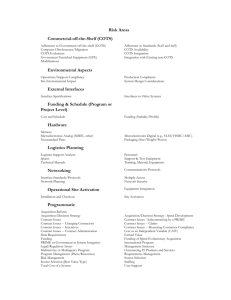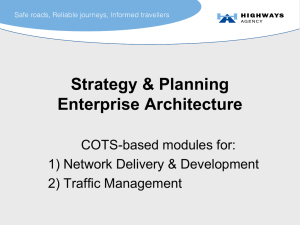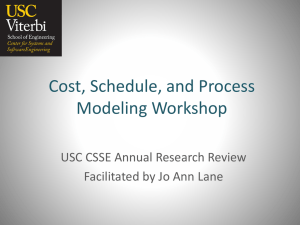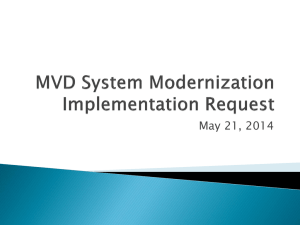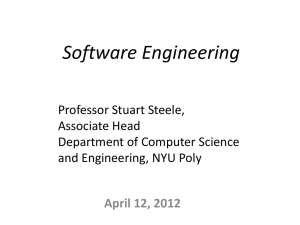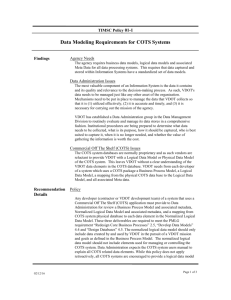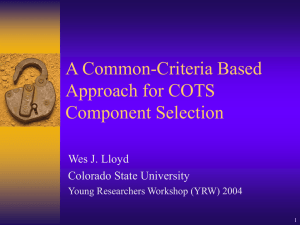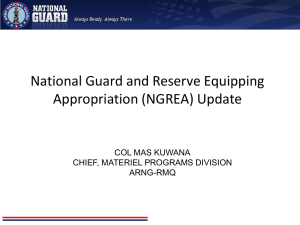Manuscript Instructions/Template for 2001
advertisement
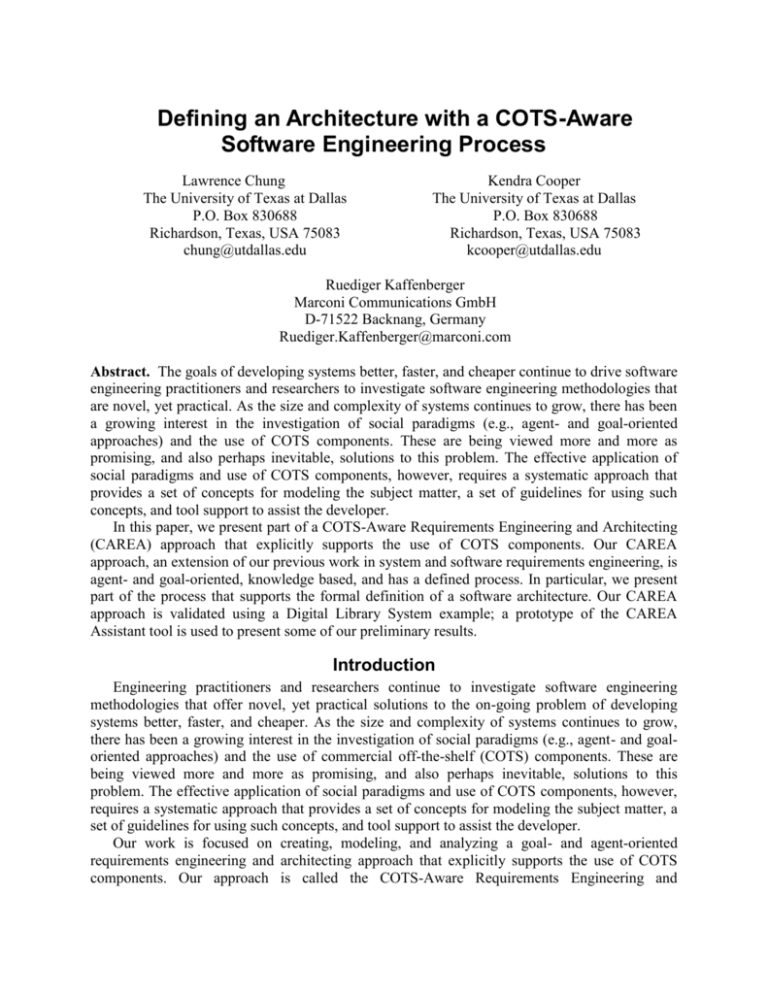
Defining an Architecture with a COTS-Aware Software Engineering Process Lawrence Chung The University of Texas at Dallas P.O. Box 830688 Richardson, Texas, USA 75083 chung@utdallas.edu Kendra Cooper The University of Texas at Dallas P.O. Box 830688 Richardson, Texas, USA 75083 kcooper@utdallas.edu Ruediger Kaffenberger Marconi Communications GmbH D-71522 Backnang, Germany Ruediger.Kaffenberger@marconi.com Abstract. The goals of developing systems better, faster, and cheaper continue to drive software engineering practitioners and researchers to investigate software engineering methodologies that are novel, yet practical. As the size and complexity of systems continues to grow, there has been a growing interest in the investigation of social paradigms (e.g., agent- and goal-oriented approaches) and the use of COTS components. These are being viewed more and more as promising, and also perhaps inevitable, solutions to this problem. The effective application of social paradigms and use of COTS components, however, requires a systematic approach that provides a set of concepts for modeling the subject matter, a set of guidelines for using such concepts, and tool support to assist the developer. In this paper, we present part of a COTS-Aware Requirements Engineering and Architecting (CAREA) approach that explicitly supports the use of COTS components. Our CAREA approach, an extension of our previous work in system and software requirements engineering, is agent- and goal-oriented, knowledge based, and has a defined process. In particular, we present part of the process that supports the formal definition of a software architecture. Our CAREA approach is validated using a Digital Library System example; a prototype of the CAREA Assistant tool is used to present some of our preliminary results. Introduction Engineering practitioners and researchers continue to investigate software engineering methodologies that offer novel, yet practical solutions to the on-going problem of developing systems better, faster, and cheaper. As the size and complexity of systems continues to grow, there has been a growing interest in the investigation of social paradigms (e.g., agent- and goaloriented approaches) and the use of commercial off-the-shelf (COTS) components. These are being viewed more and more as promising, and also perhaps inevitable, solutions to this problem. The effective application of social paradigms and use of COTS components, however, requires a systematic approach that provides a set of concepts for modeling the subject matter, a set of guidelines for using such concepts, and tool support to assist the developer. Our work is focused on creating, modeling, and analyzing a goal- and agent-oriented requirements engineering and architecting approach that explicitly supports the use of COTS components. Our approach is called the COTS-Aware Requirements Engineering and Architecting (CAREA) approach. It is agent-oriented as in (Yu 1994)(Wooldridge 2001), goaloriented as in (Anton 1998)(Chung 2000)(van Lamsweerde 2000), has a defined process as in (Maiden 2002), and is knowledge-based as in (Liu 1995)(Rolland 1994). The CAREA approach is intended to provide a framework for integrating and extending existing work in agent-oriented, goal-oriented, requirements engineering (RE), architecture, conceptual modeling, and COTS research. Due to this integrative approach, there are a number of related techniques that we draw upon including the Rational Unified Process model (Jacobson 1999)(Krutchen 1998), Model Based Architecting and Software Engineering framework (Boehm 1998)(Boehm 2000), and the Procurement Oriented Requirements Engineering technique (Maiden 2002)(Ncube 1999). Due to space constraints, we refer the reader to (Chung 2002a)(Chung 2002b) for surveys on these techniques. The CAREA approach is intended to assist the engineer in developing high quality specifications, not to replace their intelligence and experience. This work may be of interest to researchers and practitioners involved in developing large-scale, complex systems. We recognize that developing the CAREA approach is an ambitious project. To accomplish the work, we are using an iterative approach to define, refine, and validate the CAREA models and tool support. This iteration is focused on developing the models and tool support for defining a system architecture. Here, we define a process model to support the definition of a software architecture. The prototype of the CAREA Assistant Tool is also extended to support the architecture definition. The approach is validated by applying it to (part of) a Digital Library System (DLS). This example is selected because it is a complex, non-proprietary system with a rich set of functional and non-functional requirements. A detailed description of the CAREA approach (including the process model, product model, meta-model, and ontology) is available in the complimentary technical report (Chung 2002b). This paper is organized as follows. Following the introduction, we present an overview of the CAREA approach from an activity-oriented perspective. This is followed by a description of the process model that supports the definition of an architecture. Part of the process is illustrated using a Digital Library System (DLS) example; the architecture is formalized and presented using a prototype of the CAREA Assistant Tool. We also present some of our lessons learned, conclusions, and areas for future work. Overview of CAREA The CAREA approach is characterized as agent-oriented, goal-oriented, knowledge based, and has a defined process (refer to Figure 1). On the right side of Figure 1, the early artifacts for the system under development are accounted for including the agents, softgoals (non-functional goals that are achieved not absolutely but in a “good-enough” sense), hardgoals (functional goals), system requirements, software requirements, and architectural elements. The traceability relationships among the artifacts are also established and maintained (e.g., a softgoal is refined and traced to specific system requirements). On the left side of Figure 1 the descriptions of the COTS components are stored and maintained in a knowledge base, or repository. For each COTS component, the high-level goals (softgoals and hardgoals) and the chosen product specifications which meet the goals are stored and maintained. The goals provide high-level descriptions of the capabilities of a COTS component; they contain information like that found on marketing brochures for existing products. These general descriptions provide enough information, at least initially, for a RE to determine if the product appears to be potentially useful and, as a result, warrants further investigation. A product specification is the detailed description of the functional and non-functional characteristics of the projected system, including its components and relationships between the components, which, as a means/solution, meets the (potentially conflicting) goals and constraints of the various stakeholders, technical constraints, laws, etc. (Davis, 1993) (Loucopolos, 1995); they contain information like that found on the technical product specifications or data sheets for an existing product. When using the CARE approach, the RE identifies possibly matching COTS components for the goals and subsequently, the requirements and architectural elements of the system under development; these mapping relationships are also established and maintained. Component Repository (Component Goals, Specifications, …) System Under Development (System Goals, Requirements, Architecture…) Softgoal2 … Goaln Goal1 Goals Goals Specification Specification Component 2 Component 1 Goals Specification System Requirement System Requirement System Architecture … Hardware Requirement Interface Requirement Software Requirement Subsystem Architecture Subsystem Architecture Architecture Elements Architecture Elements Component n Legend Mapping System Goals to Component Goals Mapping Requirements to Component Specification Mapping Architectures to Component Specifications Agent Figure 1. Mapping System Goals, Requirements, and Architectures to Components In this section, we present an overview of the CAREA process model; a detailed description is available in (Chung 2002b). An overview of the CAREA process is illustrated in Figure 2 using the IDEF0 notation (FIPS 1993). The IDEF0 notation is activity oriented, and is suitable for describing a process. Activities in the IDEF0 notation have inputs, mechanisms, controls, and outputs. An activity transforms inputs into outputs and is represented with a labeled rectangle. Inputs and outputs are represented with arrows arriving at the left-hand side of the activity and leaving the right-hand side respectively. Mechanisms are the people or tools that perform the activity; these are represented with labeled arrows arriving at the bottom of the activity. Controls are used to constrain when or how the activity can be done; these are represented as labeled arrows arriving at the top. At this high level, the activities of the CAREA approach include Define System Agents, Define System Goals (with COTS), Define System Requirements (with COTS), Define Software Requirements (with COTS), Maintain COTS Repository, and Define Architecture (with COTS) (refer to Figure 2). Each of these is described in more detail by decomposing the activity. The CAREA process defines the goals, requirements, and architecture with an iterative and interleaving approach; this approach supports the use of COTS components. In CAREA the selection of possible COTS components begins very early in the development lifecycle when the goals are being defined (Chung 2002a). The requirements engineer (RE) maps goals and requirements to possible matches of COTS components by searching, matching, and selecting from the components in the repository. The RE, with the assistance of the component engineer (CE) and the system or software architect (SA), considers the functional and non-functional capabilities and the impact of using a component on the software architecture. If a match is not found, then the RE has a number of options. The RE may ask the CE to find another component in the marketplace and add it to the repository. The RE may try bridge the gap between the customer's needs and the capabilities available in the components by asking the vendor to change a component or asking the customer to change a goal or requirement. Using this process, the goals and requirements are negotiated and refined while considering the constraints imposed by COTS components. As the goals and requirements are being developed, the SA outlines the system architecture. When system goals, system requirements, software requirements become available, the SA uses them to refine the architecture model. With the assistance of the CE, the SA evaluates COTS components already mapped from goals and requirements and may search, match, and select additional COTS components in the repository. Again, if a COTS component is not available the SA has several options. The SA may ask the CE to find another component in the marketplace and add it to the repository, ask a vendor to change a component, or ask the RE to negotiate a change to a goal or requirement with the customer. As a result, the goals, requirements, and system architecture are negotiated and refined while considering the constraints imposed by COTS components. The artifacts relating the co-definition of the goals and requirements with the RE and CE Expertise Initial System Concept, System Goals (WIP, Baselined, Corrections), System Requirements (WIP, Baselined, Corrections), Software Requirements (WIP, Baselined, Corrections), Component Repository Architecture (WIP, Baselined , Corrections), SA Decisions Define Architecture (with COTS) 5 System Goals (WIP, Baselined, Corrections), System Requirements (WIP, Baselined, Corrections), Software Requirements (WIP, Baselined, Corrections) Architecture (WIP, Baselined, Corrections), Component Repository SA Elicitation Tech. Initial System Concept, Enterprise Goals Define WIP System Agents, System RE Decisions Agents 1 Baselined System Agents RE Initial System Concept, WIP Architecture, Component Goals, Enterprise Goals Corrections to System Goals Update Component Goals, Update Component Specs. RE and SA Expertise Maintain Component Repository CE Updated Component 6 Repository, CE Decisions Elicitation Tech., COTS Decision Tech., SA and CE Expertise Update Component Goals WIP System Goals, RE Decisions Baselined System Goals (with COTS) Define System Goals 2 RE Component Specs., WIP Architecture Elicitation Technique, COTS Decision Technique Define Update Component Specs. System WIP System Requirements, RE Decisions Reqs. Baselined System Requirements (with COTS) 3 RE Corrections to System Reqs. Component Specs., WIP Architecture Elicitation Tech., COTS Decision Tech., SA and CE Expertise Define Software Reqs. RE 4 Update Component Specs. WIP Software Requirements, Baselined Software Requirements (with COTS), RE Decisions Corrections to Software Reqs. Figure 2. A High Level Activity-oriented View of CAREA architecture are highlighted in blue in Figure 2. Defining an Architecture with the CAREA Process In the overview of the CAREA process (refer to Figure 2), one of the steps is to Define the Architecture (activity 5). CAREA is concerned with both systems architecture and software architecture. Since systems engineering is a predecessor to software engineering, we believe it is of paramount importance to detect model mismatches at the earliest possible moment, concerning both the context in which the projected software system is to function and the software system functionality. Here, we focus on defining and validating the activities used to define the software architecture; we plan to extend CAREA to support the system architecture definition in the next step of the work. Defining the software architecture is decomposed into activities to select architectural styles, define, establish traceability from the requirements to the architecture, analyze, correct, verify, integrate, and baseline subsystems. We (partially) illustrate the process using a Digital Library System (DLS) example. Due to space constraints, only part of the example is presented. In each step, the SA documents the decisions and the rationale for the decisions performing the task. Select Architectural Style(s). The SA selects one or more architectural styles to define the overall structure of the software solution. Architectural styles capture a recurring solution to a recurring problem (Clements 2002). Examples of styles in (Bass 2002) include independent components (e.g., client server), data flow (e.g., pipe and filter), data-centred (e.g., repository), virtual machine (e.g. rule based), and call/return (e.g. layered). The SA uses the initial concept of the system, goals, and requirements to select the style(s); they can overlap or can contain one another hierarchically. For the DLS, the SA examines the initial concept of the system to identify the (initial) architectural styles used; the SA selects client-server, layered, and repository. The overall structure of the architecture is illustrated in Figure 3. … Client Client (maximum 500 clients) Server CHI Layer CHI Layer Loadsharing Configuration Server Server Manager Layer (web) Client Manager Layer Client Manager Layer Proxy Server Manager Layer (web) Library Repository Security Layer Security Layer Library Repository Communication Layer Communication Layer Communication Layer Communication Layer Real Time O/S Layer (Utilities) Real Time O/S Layer (Utilities) Real Time O/S Layer (Utilities) Real Time O/S Layer (Utilities) Logical Communication Figure 3. Initial DLS Architecture Outline Define Subsystem Architecture. Once the architectural styles are selected, the SA defines the subsystems. For example, if a layered style is used, then each layer is a subsystem that needs to be defined in terms of its capabilities (i.e., meets specific functional requirements), interfaces, and constraints (i.e., meets specific non-functional requirements). As the subsystems are defined, the SA may update the architectural styles used and/or update the topology (e.g., three layers may be redefined as two layers). For the DLS, the SA defines the CHI layer as: Capabilities. The CHI layer manages the presentation of audio, video, and images, a graphical user interface, supports the extensible markup language (XML), type and range error checking on user inputs, and builds and decodes requests going to/arriving from Client Manager layer. Interfaces. The CHI Layer uses the Client Layer to process the following request/responses: log-on, log-off, add library object, search for library object, modify library object, delete library object, add user account, modify user account, search for user account, delete user account, … Constraints. 1) Complies with the following standards: Extensible Markup Language (XML), MPEG, JPEG, … 2) Non-COTS code is implemented with JAVA. Establish Traceability. The SA establishes the traceability between the requirements and the subsystems. For the DLS, the SA traces system requirement 023, which states that the DLS shall provide the capability to present files in the motion picture expert group 3 standard (MPEG-3), to the CHI Layer. Analyze, Correct, and Verify Subsystem Architecture. The SA analyzes each subsystem description to identify errors of commission (e.g., conflicting, incorrect, or redundant capabilities, interfaces, or constraints) and omission (e.g., missing capabilities, interfaces, or constraints). The SA corrects the definitions of the subsystems based on the analysis results. Once the subsystem is corrected, the SA verifies it with respect to the system goals, system requirements, and software requirements. The SA identifies errors of commission and omission. For the DLS, the SA analyzes the subsystem architecture; a number of errors are detected and corrected. Typical errors include descriptions of capabilities, interfaces, and constraints that are marked as "TBD" and incomplete references to standards. For example, in the CHI Layer description the specific version of XML standard not specified and needs to be corrected. The current version of this standard is 1.0, October 2000. Once the subsystem is corrected the SA verifies it with respect to the system and software requirements. Using the traceability, a number of errors are detected in this step. For example, the traceability report indicates the CHI layer supports the requirement to present audio-video using MPEG-3; this is not included in the layer’s description and is added. Define COTS Subsystem Architecture. Once the subsystems are verified, the SA determines if COTS components are available that may provide the capabilities, match the interfaces, and match the constraints. Earlier in the CAREA process, potential matches are identified when the goals and the requirements for the system under development are defined. If components are already identified, then the SA determines if one or more of the components are a match for the current definition of the architecture. If one or more components are a good match, then the SA selects a component. Currently, selection technique in CAREA is ad-hoc (i.e., relies solely on the experience of the SA). In the future, CAREA will be extended with multi-criteria decision making techniques. If there is not a good COTS match, then the SA has several options. The SA may a) determine the impact of selecting one of the possible components on the architecture b) consult with the CE and request a search for additional components c) consult with the RE and determine if the requirements can be modified d) develop the subsystem from scratch. For the DLS, when the SA begins to define the COTS components used in the CHI Layer, the JAVA Media Framework (JMF) components have already been identified by the RE. After investigating (reviewing the RE's rationale for selecting the components, searching the repository, matching and analyzing additional components), the SA determines the JMF is the best COTS component available to deliver the capabilities needed. Integration and Baselining. Once subsystems are defined, they need to be iteratively integrated, analysed, corrected, and verified. The integration may proceed top down, bottom up, or middle out. This large activity is described in (Chung 2002b). Ultimately, the SA and CM baseline the verified, integrated architecture and place it under configuration management. The DLS example is further illustrated using the prototype of the CAREA Assistant Tool. The prototype supports a subset of the constructs in the meta-model, including the agents, goals, system requirements, software requirements, COTS components, architecture, and a set of basic queries. The tool uses the deductive object management database tool called ConceptBase (ConceptBase 2002), which supports the O-Telos language (Mylopoulos 1990). O-Telos is a descendant of RML (Greenspan 1994) - an object-oriented requirements modeling language for functional requirements. O-Telos provides a formal, object-oriented notation with classification, generalization, aggregation, attribution, and time. Using the semi-formal CAREA architecture, the classes for the architecture and instances for the DLS example are defined in O-Telos and included in the knowledge base of the CAREA Assistant Tool. Examples are available in (Chung 2002b). Part of the DLS architecture is presented graphically in Figure 4. Figure 4. Partial Illustration of the Formalized Architecture We have already learned a number of lessons in developing this phase of the work. The formalization into O-Telos class definitions has encouraged the development of a more complete, consistent, and correct process model. As the model was being developed, it became an iterative process to define, validate, and correct the definitions. In particular, when formalizing the subsystem architectures in O-Telos, the following problem arose: How do we translate parts of the architecture that are defined with overlapping styles? For example, the client server style defines specific interface types for the process communication; these types need to be related to layers within the client and sever. After several iterations, this problem is addressed by refining the definitions, for example, of an interface as a class, not a simple attribute. With this approach, instances can be related across "chunks", or overlapping styles, of the architecture. When displaying all the relationships, however, the graphical representation of the architecture became difficult to read. The GraphicBrowser tool that is available with ConceptBase currently does not support moving the relationships or the labels on the relationships. ConceptBase does provide an API; we propose to use the API to build a more flexible interface for displaying the architecture model. CONCLUSIONS AND FUTURE WORK In this paper, our contribution is to present our preliminary work in the CAREA approach that supports the definition of a software architecture as the goals and requirements are being defined. We present part of the process model and illustrate it with an example from a Digital Library System. A more detailed description of CAREA is available in (Chung 2002b). The activity step to define the architecture is refined into steps to select architectural styles, define subsystem architectures, establish traceability from the requirements to the subsystem architectures, analyze, correct, verify, define COTS, and integrate subsystems, and baseline an architecture. Classes and instances of agents for part of a Digital Library System are formalized in the O-Telos notation and presented using a prototype of our CAREA Assistant Tool. As we have only used one example system to validate the work, we recognize that additional validation with different systems is needed. The next example system we intend to use is a telepresence system. We also plan to extend and refine the CAREA approach's process, product, and meta-model and tool support. More specifically, we propose to a) extend the prototype to support reasoning about contradictory, non-functional goals as in (Chung 2000), b) develop a better user interface using the API in ConceptBase for the CAREA Assistant Tool, c) extend the knowledge base with additional architectural styles, and d) extend the approach to support the definition of a system architecture. REFERENCES Antón, A., Potts, C., “The Use of Goals to Surface Requirements for Evolving Systems”, Int. Conf. on Software Engineering, Kyoto, Japan, 19-25 April 1998, pp. 157-166. Bass, L., Clements, P., and Kazman, R., Software Architecture in Practice, Addison Wesley Longman, Inc., 1998. Boehm, B., Port, D., Abi-Antoun, M., and Egyed, A., “Guidelines for the Life Cycle Objectives (LCO) and the Life Cycle Architecture (LCA) deliverables for Model-Based Architecting and Software Engineering (MBASE)”, TR USC-CSE-98-519, USC-Center for Software Eng. Boehm, B. “Requirements that handle IKIWISI, COTS, and Rapid Change", IEEE Computer, Vol. 33 Issue: 7, July 2000, pp. 99 –102. Brownsword, L., Oberndorf, T., and Sledge, C., “Developing New Processes for COTS-Based Systems”, IEEE Software, July/August 2000, pp. 48-55. Chung, L., Nixon, B., Yu, E., and Mylopoulos, J., Non-Functional Requirements in Software Engineering, Kluwer Academic Publishing, 2000. Chung, L. and Cooper, K., "A COTS-Aware Requirements Engineering Process: a Goal-and Agent Oriented Approach", Proc. of the Int. Council on Systems Engineering Symposium, 2002 (INCOSE '02), Las Vegas, Nevada. Chung, L. and Cooper, K., "A COTS-Aware Requirements Engineering and Architecting Approach: Defining System Level Agents, Goals, Requirements, and Architecture", TR UTDCS-20-02, The University of Texas at Dallas, 2002. Clements, P., Kazman, R., and Klein, M. Evaluating Software Architectures Methods and Case Studies, Addison-Wesley, USA, 2002. ConceptBase, A deductive object manager for meta databases, Aachen University of Technology (RWTH), Germany, version 5.2, 2002. Davis, A. M., Software Requirements: Objects, Functions, States. Prentice Hall: Englewood Cliffs, 1993. Federal Information Processing Standard (FIPS) Publication 183, Integration Definition for Function Modeling (IDEF0), December 21, 1993. Greenspan, S., Mylopolous, J., and Borgida, A., “On formal requirements modeling languages: RML revisited”, 16th Int. Conf. on Software Eng., 1994, pp. 135-147. Jacobson, I., Booch, G., and Rumbaugh, J., The Unified Software Development Process, Addison Wesley Longman, Inc., USA, 1999. Kruchten, P., “Modeling Component Systems with the Unified Modeling Language”, Int. Workshop on Component-Based Software Eng., 1998,http://www.sei.cmu.edu/cbs/icse98/papers/p1.html. Liu, A. and Tsai, J.J.P., "A knowledge-based approach to requirements analysis", 7th Int. Conf. on Tools with Artificial Intelligence, 1995, pp. 26 - 33. Loucopoulos, P. and Karakostas, P., System Requirements Engineering, McGraw-Hill, 1995. Maiden, N.A.M., Kuim, H. and Ncube, C. “Rethinking Process Guideance for Software Component Selection", Proc. of the 1st Int. Conf. of Component Based Eng., 2002, pp. 151164. Mylopoulos, J., Borgida, A., Jarke, M., and Koubarakis, M., “Telos: Representing Knowledge about Information Systems”, ACM Trans. Info. Sys., 8 (4), October 1990, pp. 325-362. Ncube, C. and Maiden, N., “Guiding parallel requirements acquisition and COTS software selection”, Proc. of the IEEE Int. Symp. on Requirements Eng. 1999, pp. 133-140. Rolland, C. and Grosz, G., "A general framework for describing the requirements engineering process", IEEE Int. Conf. on Systems, Man, and Cybernetics, 1994, vol. 1, pp. 818 - 823. Yu, E., “Modelling Strategic Relationships For Process Reengineering”, DKBS-TR-94-6, Univ. of Toronto, Canada, Dec. 1994. van Lamsweerde, A. and Letier, E., “Handling Obstacles in Goal-Oriented Requirements Engineering”, IEEE Trans. on Software Eng., Vol. 26, September 2000, pp. 978-1005. Wooldridge, M. and Ciancarini, P., "Agent-Oriented Software Engineering: The State of the Art," Handbook of Software Engineering and Knowledge Engineering, World Scientific Publishing Co., 2001, pp 1-28. BIOGRAPHIES Lawrence Chung is an Associate Professor in the department of Computer Science at The University of Texas at Dallas. He received a Ph.D. in Computer Science from The University of Toronto, is on the editorial board of Requirements Engineering Journal, and is the principal author of "Non-Functional Requirements in Software Engineering". Kendra Cooper is an Assistant Professor in the department of Computer Science at The University of Texas at Dallas. She received a Ph.D. in Electrical and Computer Engineering from The University of British Columbia. Her research interests include requirements engineering, system and software architecture, formal methods, and the empirical assessment of software engineering methodologies. Ruediger Kaffenberger has worked as a systems engineer for more than eight years. He is now with the Access Networks Division of Marconi Communications. Ruediger Kaffenberger received a M.S. degree in Electrical Engineering from the Univeritat Stuttgart. He is a founding member of INCOSE German Chapter, and a member of the IEEE and the IEEE Computer Society.
